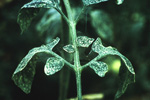Entomopathogenic fungi: a second line of defence against spider mites
The two spotted spidermite, Tetranychus urticaeis a major pest of protected edible crops world-wide. At present, control of T. urticae relies heavily on the use of acaricide sprays. However resistance problems and public concerns about chemical treatments have led growers to increase their use of biological control.
In the UK, T. urticae is a particular problem on glasshouse-grown tomato and control is based on applications of the predatory mite Phytoseiulus persimilis reinforced with sprays of acaricides. However differences in the establishment and developmental rates of the predator and the prey have resulted in a strong dependency on acaricides and the evolution of resistance.
Sustainable, acaricide-free control of T. urticae will be based ultimately on a suite of natural enemies that complement one another’s activities at different times during crop and pest development. On protected crops, control is most effective if this includes a fast-acting agent that can be used as a second line of defence to preventative control with arthropod natural enemies. This approach has been pioneered for arrange of pests of protected crops in the UK by Rob Jacobson (ex Warwick HRI and now and independent consultant) and is highly successful if done correctly.
In this research funded by the Horticultural Development Company (project PC163), a collaborative team from Warwick HRI (Dave Chandler, Gill Prince) and Stockbridge Technology Centre (Rob Jacobson, Pat Croft) investigated entomopathogenic fungi as a second line of defence against T. urticae.
We developed a lab bioassay to measure the susceptibility of T. urticae to infection by fungal spores. Forty candidate isolates of fungi from nine different species were screened. Six of the more effective isolates were chosen for further study in a multiple dose bioassay.
Work was also done to investigate the ways in which spider mites become infected by entomopathogenic fungi. Control with Beauveria bassiana was significantly increased when mites acquired fungal spores from leaf surfaces rather than being sprayed directly with a spore suspension. This suggests that spores of some fungi may be adapted to enhance secondary pick-up from the leaf surface.
In a large scale glasshouse experiment, five entomopathogenic fungi, applied as sprays, significantly reduced spider mite populations on mature tomato plants. The most effective treatment was B. bassiana, applied as a commercial product. In a second experiment, this product was used as a second line of defence to the predatory mite Phytoseiulus persimilis, and compared against the selective acaricide, Torq (fenbutatin oxide). A single spray of the fungus caused a 98 % reduction in numbers of T. urticae adults, nymphs and eggs. There was no evidence that the fungus was deleterious to bumblebees used in the crop.
Selected reference:
Chandler, D., Davidson, G., & Jacobson, R. J. (2005). Laboratory and glasshouse evaluation of entomopathogenic fungi against the two-spotted spider mite, Tetranychus urticae (Acari: Tetranychidae), on tomato, Lycopersicon esculentum. Biocontrol Science and Technology 15, 37 - 54.

Spidermite damage on tomato

Spidermites infected with Beauveria
